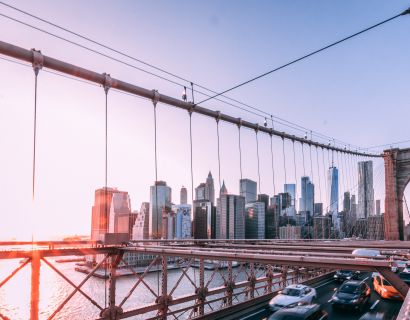Everything for  Business
Business
 Business
Business
 Business
Business
Retail rents are rising and vacancy rates are falling in this trendy Brooklyn neighborhood as more residents shop locally.

The shopping boom in Brooklyn's trendy Williamsburg neighborhood is the latest sign that remote work is helping to revitalize retail real estate in New York City's residential neighborhoods.
More than two years after the covid-19 pandemic began, many of the area's wealthy residents are still working from home for at least part of the week and buying their clothes, food, household items and other goods nearby. The increase in daily pedestrian traffic attracts retailers.
Williamsburg landlords filled 123,000 square feet of net retail space during the first quarter of this year, according to Data from CoStar Group Inc., the highest level since the third quarter of 2016. Rents that fell when Covid-19 hit rose to $64 per square foot last quarter from $54 per square foot a year earlier, according to CoStar.
Quite early during the pandemic, when remote workers moved their purchases to local stores, it became apparent that businesses in New York City's residential neighborhoods were performing better than those in the city's office and tourist areas. But the recent increase in demand for retail space in Williamsburg shows that companies are betting that working from home — and these new buying habits — are permanent, brokers and landlords say.
From desired residences to major commercial transactions.
On North 6th Street, one of Williamsburg's most coveted shopping districts, retail vacancy rates have fallen to about 11%, or about half as much as at the end of 2019, CoStar data showed. National and global brands, including Nike Inc., Patagonia and Google, have recently joined local merchants.
The Birkenstock store on North 6th Street, which opened during the pandemic, saw a steady stream of customers within an hour of opening Friday morning. Williamsburg resident Leila Nicknam, a 35-year-old sustainability consultant, stopped to return a pair of sandals.
While she usually buys clothes online, Ms Nicknam said she eats more often in Williamsburg than before the pandemic. "I used to work in the city, so I ate all over the office," she said.
Brandon Singer, chief executive of retail leasing and consulting firm Mona Retail Holdings, said retail space on North 6th was rented for $100 per square foot before the pandemic. Now, the requested rent is approaching $300 per square foot.
"It used to be a little bit more direct consumer brands that signed leases there," Mr. Singer said. "Now luxury and more traditional retail concepts are also flocking to the market."
Retailers in other areas of New York City benefit from residents working from home, Mr. Singer said. But Williamsburg is unique in the sense that the stronger daytime population combined with the district's steep factor attracts national and international brands, he said.
For years, many of the service-oriented retailers in the area have struggled to reach the level of sales they needed, said Jeff Muallem, chief executive of retail landlord Gazit Horizons, which owns 60,000 square feet of Williamsburg retail in four residential buildings. "That changed after people started staying home more," he said.
Previously floundering tenants enjoyed increased sales and are now renting, Mr Muallem said. The new tenants have signed leases including a pet garden, a restaurant, a massage studio and a bicycle shop. Gazit's total retail volume, which was 83% occupied before the pandemic, was fully leased by the middle of last year, and Mr Muallem said he was able to increase rents by up to 25%.
Williamsburg's strength as a shopping destination is rooted in Brooklyn's population growth, which began gaining momentum six years ago, accelerated during the pandemic and far outpaced the rest of the city, said Thomas LaSalvia, senior economist at Moody's Analytics. In recent years, Williamsburg has thrived on apartment construction, almost all of them affluent in amenities, Class A buildings, and requested rents in the area have risen from an average of $3,900 a month in 2018 to $4,700 this year, Mr. LaSalvia said.
As the pace of relocation of young professionals to Williamsburg accelerated, investors began to buy up retail real estate. However, the new owners had trouble finding tenants willing to pay high prices for retail space.
How has the real estate market in your area changed over the past year? Join the discussion below.
Some retailers, including eyewear company Warby Parker Inc. and menswear retailer Buck Mason, were renting space on North 6th Street, and landlords across the area began asking for rents of about $70 per square foot in the year leading up to the pandemic. But many shop windows on the street were left empty.
"The rents were just out of order," said Ben Weiner, executive managing director of real estate firm Ripco Real Estate. "It was a very popular place to be at night or on weekends. The area just didn't have the same daytime population that most other strong retail markets have."
The landlord Mr. Weiner represents on Metro Avenue had trouble renting his first-floor store before the pandemic. Last year, requests began to arrive before the premises entered the market, and the landlord is close to signing a lease agreement 50% more than the former tenant paid.
"It's just a completely different market than before the pandemic," Mr. Weiner said.
 The Sunbelt Land Boom Brings Big Profits and Big Risks
The Sunbelt Land Boom Brings Big Profits and Big Risks
 Asia's office life revives in Hong Kong and Singapore
Asia's office life revives in Hong Kong and Singapore
 America's Office Surplus Began Decades Before the Pandemic
America's Office Surplus Began Decades Before the Pandemic
 Member-only clubs are popping up all over Manhattan, providing an alternative social center and workspace as New Yorkers spend less time in the office.
Member-only clubs are popping up all over Manhattan, providing an alternative social center and workspace as New Yorkers spend less time in the office.
 The historic project of affordable housing in Miami received a second wind
The historic project of affordable housing in Miami received a second wind
This site uses cookies and other visitor identifiers for the convenience of each user. If you stay on our site after reading this message, it means that you have no objection to the use of these technologies. Learn more
